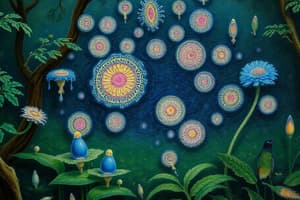Podcast
Questions and Answers
Which of the following is the structural and functional unit of all living organisms?
Which of the following is the structural and functional unit of all living organisms?
- Organ
- Cell (correct)
- Tissue
- Organelle
What is a group of organs with related functions working together to perform body functions called?
What is a group of organs with related functions working together to perform body functions called?
- Tissue
- Organelle
- Organ system (correct)
- Cell
Which of the following is an example of an organ?
Which of the following is an example of an organ?
- Brain (correct)
- Plant cell
- Blood cells
- Xylem tissue
What defines an organism?
What defines an organism?
Which of the following is an example of a unicellular organism?
Which of the following is an example of a unicellular organism?
Flashcards
What is a cell?
What is a cell?
The basic building block of all living things, responsible for structure and function.
What is an organ system?
What is an organ system?
A collection of organs working together to perform specific bodily functions.
What is an organ?
What is an organ?
A specific part of an organism that performs a particular function, made of tissues.
What is an organism?
What is an organism?
Signup and view all the flashcards
What is a unicellular organism?
What is a unicellular organism?
Signup and view all the flashcards
Study Notes
Levels of Organization in Cell Structure
- Cells are the fundamental structural and functional units of all living organisms.
- Examples of cells include blood cells, nerve cells, and plant cells.
- Tissues are groups of cells with similar structure working together to perform specific shared functions.
- Examples of tissues include xylem tissue and blood tissue.
- Organs are structures made up of groups of tissues working together to perform specific functions.
- Examples of organs include the brain, heart, and leaf.
- Organ systems are groups of organs with related functions working together to perform body functions.
- Examples of organ systems include the circulatory system, nervous system, and flower.
- Organisms are living things with organized structures that can perform processes such as respiration, excretion, nutrition, growth, sensitivity, reproduction, and movement.
- Some organisms, like bacteria and amoeba, are unicellular, made up of a single cell.
- The leaf is mentioned as an example of an organ, demonstrating the level of organization in cell structure.
- The leaf is part of an organ system and is made up of tissues and cells that work together to perform specific functions.
Studying That Suits You
Use AI to generate personalized quizzes and flashcards to suit your learning preferences.
Description
Test your knowledge of cell structure and levels of organization with this quiz. Explore the roles of organelles, cells, tissues, organs, and organ systems in the structure and function of living organisms.




